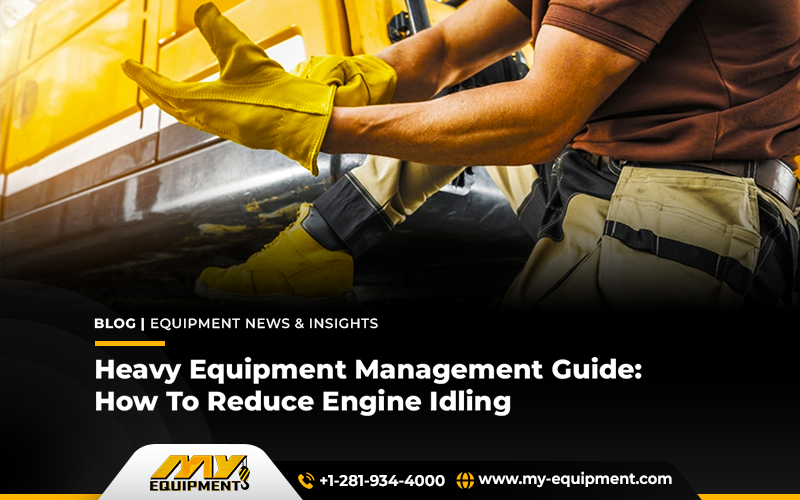To increase the productivity of any heavy equipment, any equipment keeper has to keep up with the idle equipment concern.
Although the process of idling may look common at first sight. It’s just like a driver has left the engine running meanwhile he delivers a package.
But do you know if the practice continues to a significant level how it can affect the environment?
From affecting finances to deteriorating heavy equipment’s productivity to noticeably impacting the environment through carbon footprints, the drawbacks of heavy equipment idling hold a long list!
What Is Heavy Equipment Engine Idling?
Leaving the engine running without moving the heavy equipment is the process of heavy equipment idling.
However, if the equipment is stuck in traffic idling is unavoidable but in the rest of the cases, one must avoid engine idling.
According to Environmental Defense Funds, thousands of equipment and vehicles idle needlessly in the U.S. To prevent excessive air pollution, the Environmental Protection Agency and NHTSA have put fines on drivers seen idling in avoidable situations.
5 Main Reasons To Stop Heavy Equipment Engine Idling
Engine idling is capable of impacting the limited fleet management budget as well as the health of the machinery to an irreversible extent.
Mentioned below are the five core reasons to minimize heavy equipment engine idling;
- Idlings tend to create ghost miles impacting the engine’s productivity
- Idling adversely impacts other components of heavy equipment
- Heavy equipment significantly impacts the fuel consumption rate
- Idling tents to make heavy equipment vulnerable to thefts
- Idling heavy equipment greatly contributes to polluting the environment
The Advantages Of Minimizing Heavy Equipment Idling Time
As a responsible fleet manager, you must opt for ways that reduce additional equipment idling time. To make you look forward to idling time reduction following are the core benefits of minimized idling;
- Reduced idling helps in saving fuel costs as well as the emission of hazardous gases.
- It helps in minimizing engine wear which automatically increases the resale value of heavy equipment.
- Noise pollution is reduced to a noticeable extent.
- Improvisation of overall air quality leading towards a clean environment.
The total idle time of a vehicle is 25% of the operating time. So the idle time highly depends on the type of heavy equipment you own.
However, according to studies large heavy equipment like motor graders and wheel loaders can idle up to 40% of the operating time.
5 Effective Tips To Reduce Heavy Equipment Idling
By now after knowing the disadvantages of excessive idling, we believe you must be finding ways to reduce equipment idling.
Don’t worry, here are the 5 effective approaches that will help you to minimize the equipment idling time;
- Dont idle an engine for more than 10 seconds
- Use driving to warm up the engines rather than idling
- Get the heavy equipment installed with Auxiliary Power Units to minimize fuel consumption
- Implement the auto start and stop technology
- Integrate a GPS tracking system to keep an eye on drivers and guide them if they are seen practicing excessive engine idling
Impact of Heavy Equipment Idling Time on Construction Finances
Let’s put out the calculator and make some logical computations to see how much of finances get wasted because of heavy equipment idling;
- Idling consumes a third portion of a fuel gallon to greater than half of a gallon per hour
- Idling of 2 to 8-ton heavy equipment can consume three-quarters of a fuel gallon per hour whereas equipment up to 16-ton can consume more than three-quarters of a fuel gallon
- A semi-trailer truck can consume more than one gallon per hour
Let’s come to the fuel cost now;
- A heavy equipment that idles for 25% of its operating time consumes $2,500 annually
- A wheel loader can consume up to $1200 in fuel annually
To learn efficient heavy equipment fuel-saving tips visit Heavy Equipment Fuel Saving Guide by MY-Equipment for FREE!
Moreover, the idle time of heavy equipment is not restricted to excessive fuel consumption. On the same side, it creates room for excessive heavy equipment maintenance. Know the latest Heavy Machinery Fleet Management Trends To Ace In 2024 and maximize your annual productivity rate.
Summary
The worst nightmare is running a vehicle with 0 mpg and that is what happens when heavy equipment idles excessively. Idling is a concern for response fleet managers due to the zero benefits it offers.
Inclusive of negative environmental impact, heavy equipment idling reduces operational efficiency as well as drinks excessive fuel to dig deep into the finances.
As a renowned used heavy equipment supplier, MY-Equipment has narrowed done the cons of idling and how you can avoid it.
By reducing it to a noticeable level you can promote environmental sustainability as well as increase the lifespan of installed heavy machinery.
Follow MY-Equipment to get relevant tips on managing and increasing the efficacy of heavy machinery while having the latest industry updates today!


 1400 Broadfield Blvd, Houston, TX 77084,
USA.
1400 Broadfield Blvd, Houston, TX 77084,
USA.